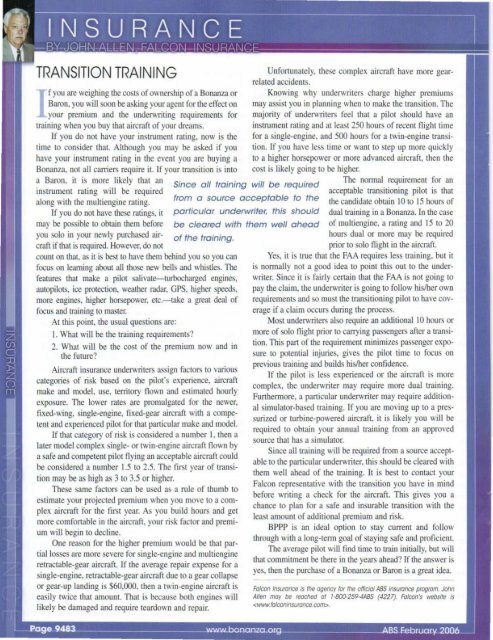Create successful ePaper yourself
Turn your PDF publications into a flip-book with our unique Google optimized e-Paper software.
TRANSITION TRAININGIf you are weighing the costs of ownership of a <strong>Bonanza</strong> orBaron, you will soon be asking your agent for the effect onyour premium and the underwriting requirements fortraining when you buy that aircraft of your dreams.If you do not have your instrument rating, now is thetime to consider that. Although you may be asked if youhave your instrument rating in the event you are buying a<strong>Bonanza</strong>, not all carriers require it. If your transition is intoa Baron, it is more likely that aninstrument rating will be requiredalong with the multiengine rating.If you do nO! have these ratings, itmay be possible to obtain them beforeyou solo in your newly purchased aircraftif that is required. However, do notcount on that. as it is best to have them behind you so you canfocus on learning about all those new bells and whistles. Thefeatures that make a pilot salivate-turbocharged engines,autopilots, ice protection. weather radar, GPS, higher speeds,more engines, higher horsepower, etc.-take a great deal offocus and training to master.At this point, the usual questions are:1. What will be the training requirements?2. What will be the cost of the premium now and inthe future?Aircraft insurance underwriters assign factors to variouscategories of risk based on the pilot's experience, aircraftmake and model, use, territory flown and estimated hourlyexposure. The lower rates are promulgated for the newer,fixed-wing, single-engine, fixed-gear aircraft with a competentand experienced pilot for that panicular make and model.If that category of risk is considered a number I, then alater model complex single- or twin-engine aircraft flown bya safe and competent pilot flying an acceptable aircraft couldbe considered a number 1.5 to 2.5. The first year of transitionmay be as high as 3 to 3.5 or higher.These same factors can be used as a rule of thumb toestimate your projected premium when you move to a complexaircraft for the first year. As you build hours and getmore comfortable in the aircraft, your risk factor and premiumwill begin to decline.One reason for the higher premium would be that partiallossesare more severe for single-engine and multiengineretractable-gear aircraft. If the average repair expense for asingle-engine, retractable-gear aircraft due to a gear collapseor gear-up landing is $60,000, then a twin-engine aircraft iseasily twice that amount. That is because both engines willlikely be damaged and require teardown and repair.Since all training will be requiredfrom a source acceptable to theparticular underwriter. this shouldbe cleared with them well aheadof the training.Unfortunately, these complex aircraft have more gearrelatedaccidents.Knowing why underwriters charge higher premiumsmay assist you in planning when to make the transition. Themajority of underwriters feel that a pilot should have aninstrument rating and at least 250 hours of recent fl ight timefor a single-engine, and 500 hours for a twin-engine transition.If you have less time or want to step up more quicklyto a higher horsepower or more advanced aircraft, then thecost is likely going to be higher.The normal requirement for anacceptable transitioning pi lot is thatthe candidate obtain IOta 15 hours ofdual training in a <strong>Bonanza</strong>. [n the caseof multi engine, a rating and 15 to 20hours dual or more may be requiredprior to solo flight in the aircraft.Yes, it is true that the FAA requires less training, but itis normally not a good idea to point this out to the underwriter.Since it is fairly certain that the FAA is not going topay the claim, the underwriter is going to follow hislher ownrequirements and so must the transi tioning pilot to have coverageif a claim occurs during the process.Most underwriters also require an additional 10 hours ormore of solo flight prior to carrying passengers after a transition.This pan of the requirement minimizes passenger exposureto potential injuries, gives the pilot time to focus onprevious training and builds hislher confidence.If the pilot is less experienced or the aircraft is morecomplex, the underwriter may require more dual training.Furthermore, a particular underwriter may require additionalsimulator-based training. If you are moving up to a pressurizedor turbine-powered aircraft, it is likely you will berequired to obtain your annual training from an approvedsource that has a simulator.Since all training will be required from a source acceptableto the panicular underwriter, this shou ld be cleared withthem well ahead of the training. It is best to contact yourFalcon representative with the transition you have in mindbefore writing a check for the aircraft. This gives you achance to plan for a safe and insurable transition with theleast amount of additional premium and risk.BPPP is an ideal option to stay current and followthrough with a long-term goal of staying safe and proficient.The average pilot will find time to train initially, but willthat commitment be there in the years ahead? [f the answer isyes, then the purchase of a <strong>Bonanza</strong> or Baron is a great idea.Falcon Insurance is the agency for the official ABS insurance program. JohnAllen may be reached 01 1·8DO-259·4A8S (4227). Falcon's websile is

















